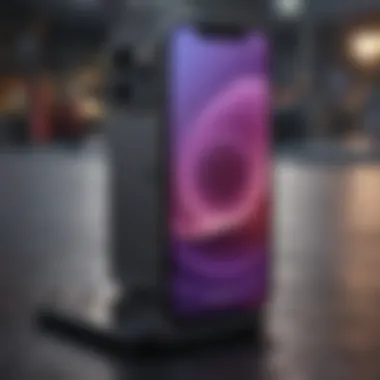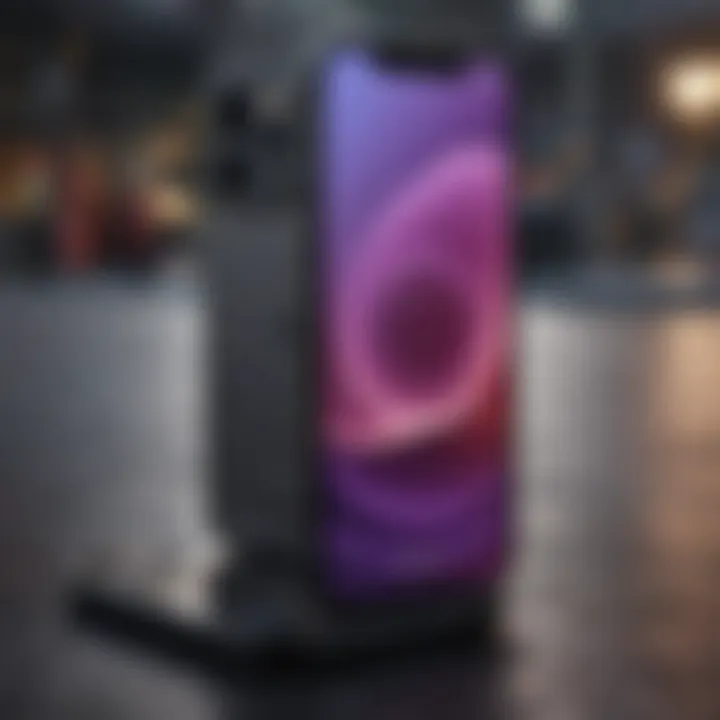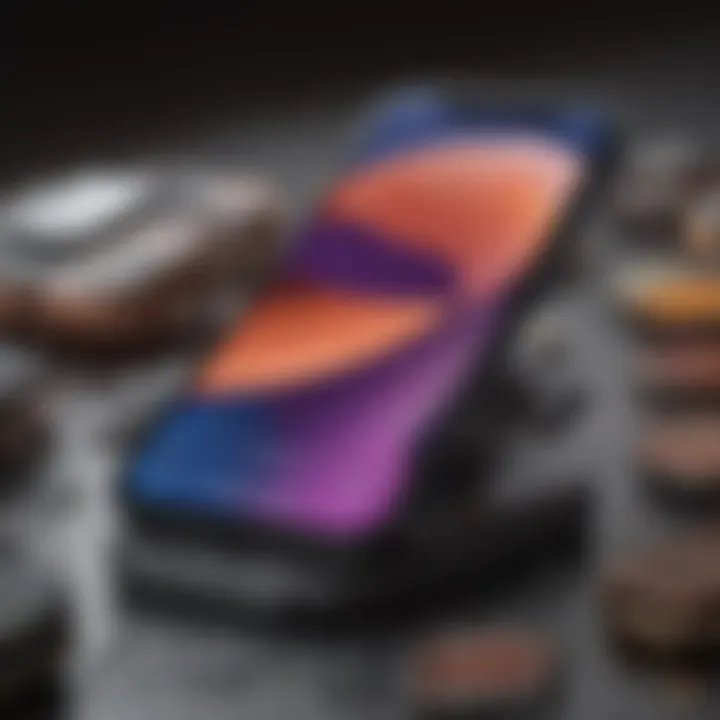Exploring the Pricing Dynamics of iPhone 13


Intro
The iPhone 13 marks another significant entry in Apple's esteemed line of smartphones. Understanding the pricing landscape of the iPhone 13 is essential for current and future Apple consumers. This analysis will uncover the various factors that influence the pricing, implications of different models, and how this device compares in a crowded market. The insights provided here will help readers make informed decisions whether they are upgrading, switching from other brands, or entering the Apple ecosystem for the first time.
Product Overview
The iPhone 13 is available in four primary models: iPhone 13 Mini, iPhone 13, iPhone 13 Pro, and iPhone 13 Pro Max. Each model differs not just in size but also in performance, camera capabilities, and price.
Key Features and Specifications
- A15 Bionic Chip: This chip provides improved speed and efficiency, making the phone ideal for multitasking and handling demanding applications.
- Display: The iPhone 13 has a 6.1-inch display, while the Pro models feature a ProMotion display for smoother scrolling.
- Camera: Enhanced cameras with improved low-light performance are a hallmark of the iPhone 13 series, adding to its appeal.
The pricing for the base models starts at $699 for the iPhone 13 Mini, scaling up to $1,099 for the Pro Max variant. This represents a strategic tiering that aims to attract diverse consumer needs.
Comparison with Previous Models
When comparing it with the iPhone 12, there are notable enhancements. The iPhone 13 offers a better battery life that extends usage time by up to two and a half hours. Additionally, camera upgrades, such as Cinematic mode, enhance video quality significantly. With each evolution, Apple addresses user feedback, making each new device more capable than the last.
Performance and User Experience
The performance metrics of the iPhone 13 are impressive, largely thanks to the A15 Bionic chip's power.
Performance Analysis
- Speed: Users experience significant speed when launching apps or gaming. Loading times are notably reduced.
- Multitasking: The device handles multiple applications seamlessly, maintaining smooth transitions.
- Battery Life: With enhanced battery capacity, users can spend more time using their phones without frequent recharges.
User Interface and Ease of Use
The user interface remains intuitive, embodying the standards Apple is known for. Even new users can quickly navigate through features thanks to its design.
User Experience Feedback
Feedback from users showcases satisfaction with both design and functionality. Many praise the camera features, particularly in low-light conditions.
Design and Build Quality
Design Elements and Aesthetics
The aesthetic quality of the iPhone 13 is notable. It features a sleeker profile with a Ceramic Shield front that Apple claims is tougher than any smartphone glass.
Materials Used in Construction
Apple utilizes a mix of glass and aluminum in the iPhone 13’s construction, ensuring both look and durability without making the device excessively heavy.
Durability and Build Quality Assessments
Independent reviews often highlight the durable build of the iPhone 13. Users report minimal wear and tear even after extensive use.
Software and Updates
Operating System Features
The iPhone 13 runs on iOS 15, which introduces new features such as Focus modes and improved FaceTime options.
App Compatibility and Availability
The device supports a wide range of apps, thanks to Apple’s robust ecosystem. Users can expect updates that keep applications running smoothly and securely.
User Customization Options
Apple allows users a degree of customization, particularly within app settings and the home screen layout, which adds a personal touch.
Price and Value Proposition
Price Point and Variants Available
As noted earlier, the pricing structure is tiered. Prospective buyers can choose from various models, which allows them to select one that fits their budget and needs.
Value for Money Assessment
Despite being a premium device, feedback suggests that users find value in its longevity and performance. The price reflects the quality and capabilities offered.
Comparison with Similar Products
When compared to competitors such as Samsung Galaxy S21 or Google Pixel 6, the iPhone 13 often holds its value better over time, making it a favorable choice for many users.
"Consumers often find that investing in an iPhone pays off through reliability and resale value."


Prolusion to the iPhone
The iPhone 13 represents a significant milestone in Apple's smartphone lineage. Understanding its pricing and structure is crucial for potential buyers and tech enthusiasts alike. This section offers insights into various models of the iPhone 13 and traces the evolution of its pricing. Knowing these details can help consumers evaluate their options and make informed decisions. The importance of this discussion stems from the growing landscape of smartphones, where price can often be the deciding factor in a consumer’s choice.
Overview of iPhone Models
The iPhone 13 series includes four main models: iPhone 13, iPhone 13 Mini, iPhone 13 Pro, and iPhone 13 Pro Max. Each model caters to different user needs and preferences, which reflects in their varied pricing structures.
- iPhone 13: This is the standard model, balancing features and cost effectively. It aims to attract typical users who seek advanced technology without extreme expenses.
- iPhone 13 Mini: This smaller variant is priced lower, appealing to users who prefer compact devices. It retains much of the iPhone 13's functionality but in a smaller form.
- iPhone 13 Pro: Targeted at users who desire enhanced capabilities. This model comes with superior cameras, more RAM, and ProMotion technology for smoother visuals.
- iPhone 13 Pro Max: The premium option that offers the largest display and highest specifications. This is for users who want the best of what Apple can provide.
Each model presents unique storage options and color choices, adding another layer of personalization which also impacts the pricing dynamics.
The Evolution of iPhone Pricing
iPhone pricing has continually evolved since the original model launched. Initially, Apple created a niche premium brand with its pricing strategy. Over time, however, iPhone prices have generally increased, reflecting inflation and advanced technology integration. Here are some factors influencing this evolution:
- Technology Advancements: Each new generation incorporates cutting-edge technologies. Features like improved cameras, longer battery life, and enhanced displays justify higher price points.
- Market Positioning: Apple positions its products as premium. This strategy affects how consumers perceive the value of the device, impacting their willingness to pay.
- Consumer Demand: High demand often allows Apple to maintain higher prices. The brand loyalty Apple enjoys provides leverage over pricing compared to its competitors.
"The iPhone has transformed from a luxury item to a widely used device, yet Apple has managed to maintain its premium pricing strategy."
This evolution in pricing illustrates how a product can create lasting impressions while adapting to market changes. Understanding these aspects is crucial when considering buying an iPhone 13.
Base Models and Their Prices
The topic of base models and their prices holds a central role in understanding the iPhone 13 pricing landscape. Each iPhone model presents a unique set of features and functionalities, shaping its target market. The base models serve as entry points into Apple's ecosystem, appealing to a wide audience while also extracting value from brand loyalty.
Considerations for pricing also highlight the specificity of model offerings, storage, and targeted user bases. When a consumer looks to invest in a smartphone, they often examine not only the cost but also what they receive in terms of technology and longevity. In essence, this section elucidates how Apple strategically positions each model within its lineup, influencing consumer choices.
iPhone
Storage Options and Prices
The storage options of the iPhone 13 offer consumers crucial flexibility. Available configurations include 128GB, 256GB, and 512GB, each with a corresponding price increase. The 128GB model, priced as the base option, has gained popularity for being sufficient for daily usage, appealing to moderate users.
The higher storage tiers are beneficial for users who consume more media or require more space for apps and data. This tiered approach to storage enhances customer satisfaction. However, it can also lead to confusion for some buyers who may not accurately assess their storage needs.
Color Variations
The iPhone 13 is available in multiple color choices, including pink, blue, midnight, starlight, and PRODUCT(RED). These variations cater to personal preferences, enhancing perceived value. This diverse offering helps attract different segments of customers, from those preferring classic aesthetics to those seeking a vibrant, trendy device.
While color options do not directly impact performance, they play an essential role in the overall consumer experience. Choices may lead some to feel that they are customizing their device, adding to the allure of purchasing.
Specifications Overview
The specifications of the iPhone 13 outline its technical capabilities, which directly correlate to its pricing. Key features such as the A15 Bionic chip, dual-camera system, and OLED display contribute significantly to the overall value proposition.
These specifications make the iPhone 13 a desirable model within the Apple ecosystem. Higher performance can often justify a higher price point, especially among tech enthusiasts looking for state-of-the-art features. Nevertheless, this also raises awareness about competing products that may offer similar features at a lower cost.
iPhone Mini
Pricing Analysis
The pricing analysis of the iPhone 13 Mini underscores its position as a more affordable option compared to the standard iPhone 13. It starts at a lower price point, which appeals to budget-conscious consumers, while featuring similar core specs. While the Mini retains robust capabilities, it is marketed to users who prefer a compact device.
The strategy here is clear. By offering the Mini at a competitive price, Apple opens doors to new customers who may have been hesitant to invest in the brand's flagship models.
Target Audience
Identifying the target audience for the iPhone 13 Mini is pivotal in understanding its role in Apple's pricing strategy. This model primarily attracts users seeking simplicity and portability. It serves tech-savvy individuals who need a powerful phone without the bulk.
By catering to this segment, Apple diversifies its consumer base and maintains its competitive edge. However, it also risks alienating users used to larger screen sizes, potentially limiting its appeal.
Advantages of the Mini
The advantages of the iPhone 13 Mini highlight its compactness and efficiency. It delivers the same core performance features as the larger models while being easier to manage and carry. For users who prioritize usability, the Mini presents a strong option.
However, the smaller form factor may have downsides, such as reduced battery life compared to its larger counterparts. It remains essential for users to weigh these factors against their needs when selecting a model.
iPhone Pro
Pricing Structure
The pricing structure of the iPhone 13 Pro sets it apart as a premium offering within the lineup. Starting at a higher price than the standard model, the Pro series is designed for consumers who place premium quality and advanced features at the top of their list.
Pricing escalates with increased storage, making it a significant investment for power users. Each price tier not only provides more storage but also enhances performance capability, making it a purposeful choice for the brand's dedicated clientele.
Pro Features


The Pro features, such as a triple-camera system and ProMotion display, serve to justify the increased pricing. These enhancements cater to photography enthusiasts and professionals who require more from their devices.
Such features enhance the iPhone 13 Pro's appeal amongst creatives and users who seek advanced functionality. Nevertheless, these enhancements may not be necessary for all, leading to potential overspending for some consumers.
User Demographics
Understanding user demographics for the iPhone 13 Pro reveals its target market as professionals and enthusiasts. These users are typically willing to invest more for cutting-edge technology. They seek devices that align with their lifestyle, often leading to brand loyalty.
However, this demographic's reliance on the latest technology also creates a dilemma for Apple. They must continue innovating to maintain consumer interest, risking alienation if the perceived value diminishes.
iPhone Pro Max
Premium Pricing Justification
Premium pricing justification for the iPhone 13 Pro Max highlights its features, aiming at the highest-end segment of users. With the largest display and enhanced battery life, it offers maximum performance and convenience.
The pricing reflects the cost to produce such advanced technology and appeals to those who desire the top-tier device in the market. It positions the Pro Max as the ultimate life tool for specific customers, often leading to an overwhelming demand.
Market Position
The market position of the iPhone 13 Pro Max further elevates its perception as an extraordinary device. Apple maintains a reputation for quality and prestige, which is reflected in the pricing strategy for the Pro Max. This model often becomes a benchmark against which competitors measure their offerings.
However, this positioning may dissuade potential buyers who do not wish to invest heavily. Consumers may feel intimidated by such a price, which can lead to missed opportunities for Apple in attracting more budget-conscious users.
Specifications Comparison
Specifications comparison sheds light on the competitive landscape of smartphones. The iPhone 13 Pro Max leads with advanced technology offerings, from its Super Retina XDR display to an impressive camera system.
However, similar features can often be found in rival brands such as Samsung or Google. Therefore, potential customers may weigh options based on price points, leading Apple to consistently reassess its pricing strategy to keep competitive.
Factors Influencing iPhone Pricing
Examining the factors influencing iPhone 13 pricing provides insight into how retailers and Apple make their pricing decisions. It is not simply about the components that make up the phone but rather a complex interplay of various elements. Understanding these factors can benefit consumers who want to make informed decisions about their investment in Apple technology. The three main areas to consider are production costs, component availability, and market demand dynamics.
Production Costs
Production costs play a significant role in determining the final price of the iPhone 13. These costs include expenses such as materials, labor, and manufacturing processes. Apple uses high-quality materials, which tend to increase production costs. For instance, the use of advanced display technologies, such as OLED screens in the iPhone 13 Pro, raises the overall costs. Additionally, labor costs varying across regions, where phones are manufactured, can impact pricing.
Moreover, the economies of scale factor into the equation. As Apple produces more units, the average cost per device can decrease, potentially leading to lower prices. However, Apple generally maintains higher prices to preserve its premium status in the market. This strategy reinforces the brand's image as a provider of high-end devices while allowing for substantial profit margins.
Component Availability
The availability of components is another crucial determinant of pricing. The global supply chain can be fragile, affected by factors like natural disasters, trade tensions, or shortages of critical materials. In recent years, the semiconductor shortage has impacted various industries, including smartphone production. If essential components become scarce, manufacturers may face increased costs that eventually reflect on consumer prices.
Furthermore, Apple's approach to sourcing components can also affect pricing. The company has been known to negotiate long-term contracts with suppliers to secure favorable pricing and ensure availability, but fluctuations in demand for these components can make prices volatile.
Market Demand Dynamics
Lastly, market demand dynamics play a pivotal role in the pricing strategy for the iPhone 13. Consumer preferences, competitive landscapes, and economic conditions all contribute to how Apple prices its products. During product launches, demand typically spikes, allowing Apple to set higher initial prices. As time passes and demand starts to plateau, Apple may lower prices or offer promotions to stimulate sales.
Additionally, competitor actions influence market prices. Brands such as Samsung and Google offer similar products, and their pricing strategies can pressure Apple to adjust pricing.
Comparative Pricing Insights
Understanding comparative pricing insights is crucial for consumers contemplating an investment in the iPhone 13. This section aims to contextualize the iPhone 13's pricing within a broader market framework. It allows potential buyers to evaluate not just the cost of the iPhone 13 in isolation but also against competing devices. As consumers, making informed choices often depends on how products measure up against one another in terms of features and price points.
Competitor Analysis
Samsung Comparisons
When comparing the iPhone 13 to Samsung’s offering, particularly the Samsung Galaxy S21, the aspect of price becomes central. Samsung's pricing strategy frequently presents competitive mid-range devices alongside its flagships. The Galaxy S21, for instance, comes with a starting price similar to the iPhone 13 but offers different features which can attract various segments of users. Key characteristics like camera technology and display quality contribute to the popularity of Galaxy devices. One unique feature of the Galaxy S21 is its adaptive refresh rate, allowing smoother scrolling and enhanced gaming experiences. However, while this feature attracts gamers, some users might find Samsung’s One UI less intuitive than Apple's iOS.
Google Pixel Options
The Google Pixel 6 serves as another comparison point. Emphasizing software optimization over hardware, the Pixel 6 showcases Google's prowess in AI and computational photography. This distinction is noteworthy for potential buyers seeking superior photography capabilities at a lower price. Google frequently markets the Pixel devices as a more budget-friendly alternative, which is a significant factor in its appeal. A standout feature of the Pixel 6 is its real-time photo enhancements, which can greatly benefit photography enthusiasts. However, its lower price point might lead to concerns about build quality and design robustness when comparing to the iPhone 13.
OnePlus Scenarios
OnePlus devices, specifically the OnePlus 9, highlight another avenue for comparative analysis. The pricing strategy from OnePlus often focuses on high-quality specifications at relatively lower prices. This aggressive pricing can make the OnePlus 9 an attractive option for consumers looking for value without greatly sacrificing performance. A key characteristic is the rapid charging technology offered by OnePlus, allowing devices to charge to full capacity in a matter of minutes. While this advantage appeals to many users, concerns about software updates and customer service experiences can deter potential buyers when compared to the Apple ecosystem.
Similar Devices in the Market
Pricing Benchmarks
Pricing benchmarks play a pivotal role in understanding where the iPhone 13 stands among equivalent devices. Analyzing the price spectrum of flagship smartphones helps to gauge the value proposition of the iPhone 13. For instance, many consider the iPhone 13's pricing as a hallmark of premium smartphones, often above average for most flagship models. A unique feature of these benchmarks is their utility in assessing whether the iPhone provides adequate features for its cost in this competitive market. However, potential drawbacks can arise, such as buyer's remorse when lower-priced competitors deliver similar performance metrics.
Feature Comparisons


Moving beyond pricing, feature comparisons reveal vital insights into the iPhone 13's competitive edge. By examining offerings from rival smartphones, consumers can discern distinctive technological advancements. A key characteristic to consider is the seamless integration of hardware and software within the iPhone 13, making it a popular choice among many Apple users. Unique features such as Face ID and the A15 Bionic chip give it an edge in user experience and performance. That said, some might argue that certain Android devices offer comparable features at lower prices, prompting buyers to weigh brand loyalty against performance and cost.
Promotional Strategies and Discounts
Seasonal Promotions
Black Friday Discounts
Black Friday discounts are a prominent component of seasonal promotions. This shopping event occurs right after Thanksgiving in the United States and marks a period when retailers offer significant discounts. For the iPhone 13, these discounts can result in substantial savings for consumers. The attractiveness of Black Friday discounts lies in the competitive nature of sales across retailers. Consumers anticipate various deals from different sellers, often leading to reduced prices on the latest devices.
A unique feature of Black Friday discounts is the timing and urgency. Shoppers feel compelled to make quick decisions as deals are often available for a limited time. This rush can be both an advantage and disadvantage. While consumers benefit from lower prices, those who are less prepared may miss these opportunities. Ultimately, Black Friday discounts can serve as a critical moment for iPhone 13 sales, driving up demand and increasing market visibility.
Back-to-School Offers
Back-to-School offers represent another vital seasonal promotional strategy. This period typically attracts students and parents looking to buy tech products for school use. For the iPhone 13, these offers can include discounts, bundled deals, or special financing options aimed at young consumers. The key characteristic of these offers is their focus on practicality and affordability, which resonates well with buyers.
The unique feature of Back-to-School offers is their alignment with the academic calendar. Many students rely on efficient devices for their studies, making the iPhone 13 a suitable choice. On the downside, these promotions may not be as deep in discounts as those offered during Black Friday. However, they still represent an essential opportunity for Apple to connect with younger users and their families.
Carrier Deals
Contract Pricing Options
Contract pricing options are fundamental in the landscape of carrier deals. Many customers choose to purchase an iPhone 13 through a carrier under a contract. This arrangement allows users to spread the cost of the device over time, usually paired with a monthly service fee. The benefit of contract pricing is the lower upfront cost, making the iPhone 13 more financially feasible for many buyers.
A notable aspect of contract pricing is the commitment it entails. Consumers agree to a service contract, which can be for two years or longer. While this can lead to overall savings, it also locks consumers into a particular carrier. If they decide to switch providers before completing the contract, potential fees may arise. Despite these drawbacks, contract pricing is a popular option for those looking to manage their tech expenses.
Trade-In Programs
Trade-in programs are increasingly prominent in the world of smartphone purchases. Apple offers trade-in options, allowing customers to exchange their older devices for credit towards the purchase of the iPhone 13. This approach enhances the affordability aspect of the new device and emphasizes sustainability by encouraging recycling of older models.
The key feature of trade-in programs is their ability to lower the overall cost. Consumers can receive considerable value for their previous phones, which can be applied directly to the purchase. One of the advantages is the seamless integration of this process into the buying experience. However, one must also consider potential drawbacks. The valuation of older devices can vary, and sometimes consumers may not receive as much value as they anticipated. Nevertheless, trade-in programs remain a beneficial tactic for both Apple and its customers, contributing to the attractiveness of the iPhone 13 in the market.
"Promotional strategies significantly enhance the appeal of iPhone 13, making it a more viable option for a diverse range of consumers."
Understanding these promotional strategies and discounts sheds light on how Apple positions the iPhone 13 within a competitive landscape. These elements not only influence the pricing but also shape consumer perceptions and buying behavior.
Long-Term Value of the iPhone
Understanding the long-term value of the iPhone 13 is crucial for consumers considering the investment in this device. The iPhone 13 not only reflects advanced technology and features but also concerns about how it holds its worth over time. This section will delve into the resale value insights and usage duration considerations that determine its long-term value.
Resale Value Insights
The resale value of the iPhone 13 is an important factor for many consumers. Generally, Apple products tend to maintain their value better than many of their competitors. Several elements contribute to this:
- Brand Perception: Apple is known for quality design and customer loyalty. Buyers are often willing to pay higher prices for used Apple products.
- Condition and Model: The specific model and its condition greatly affect resale value. The newer and more advanced models, like the iPhone 13 Pro Max, often fetch a higher price.
- Market Trends: The timing of resale plays a role as well. Reselling shortly after a new release can yield better return on investment, but over time the depreciation rate slows.
According to various studies and market insights, the iPhone 13 could maintain approximately 65-70% of its original value after a year, depending on the model and market conditions. This highlights the iPhone 13 as a potentially sound investment for long-term use.
Usage Duration Considerations
When considering the long-term value of the iPhone 13, the duration of its usability is a key aspect. Factors influencing how long an iPhone remains functional include:
- Software Updates: Apple is notable for supporting older devices with software updates for several years. The iPhone 13 is expected to receive updates until at least 2026, ensuring it stays relevant and secure.
- Build Quality: The materials used in making the iPhone 13 enhance its longevity. Users often find that maintaining iPhones requires less frequent replacements than competitors.
- User Habits: How an individual uses their device also affects its lifespan. Regular maintenance, such as using protective cases and avoiding extreme conditions, can prolong the usability of the phone.
In summary, the iPhone 13 not only promises a solid resale value but also an impressive duration of use. This makes it attractive for individuals who prioritize both current functionality and future returns on their investment.
Finale: Understanding the iPhone 's Worth
This section reflects on the significance of pricing for the iPhone 13 in the broader context of consumer technology. The price is not just a number; it encapsulates the value, engineering, and brand perception of Apple devices. Consumers must navigate this pricing landscape carefully. A clear understanding of the iPhone 13's pricing helps potential buyers grasp what they are truly getting for their investment.
One must consider various elements when evaluating the worth of the iPhone 13. These include the features provided, the longevity of the device, and resale value. Apple’s ecosystem enhances the overall experience, which justifies the often higher price point compared to competitors. Acknowledging this helps consumers weigh their options better.
Additionally, price variations across different models play a critical role in consumer decision-making. Shoppers often compare features and differences in cost across the iPhone 13, iPhone 13 Mini, iPhone 13 Pro, and iPhone 13 Pro Max. This comparison can help clarify which model fits personal needs and budget constraints.
Ultimately, understanding the iPhone 13's worth is crucial for making an informed purchasing decision in a saturated market.
Final Thoughts on Pricing
The pricing of the iPhone 13 models provides insights into Apple's marketing strategies and consumer targeting. The standard iPhone 13 caters to everyday users, while the Pro models appeal to customers seeking advanced functionalities.
Each model's price reflects its unique positioning. The iPhone 13 has a competitive price for its feature set. Meanwhile, the Pro and Pro Max models command a premium due to their added sophistication.
It's important to take ongoing changes in market demand into account. Prices may fluctuate, affecting buyer sentiments and decisions. Therefore, undecided consumers should anticipate timing for their purchase.
Future Pricing Trends
As technology evolves, so do pricing structures. With the introduction of new models, the iPhone 13 may experience shifts in its resale value and market perception. For current and future consumers, understanding trends is essential for anticipating future costs.
We can expect Apple to continue refining its pricing strategy. Factors such as competition from companies like Samsung and Google will influence the pricing dynamics.
Moreover, changing consumer preferences, technological advancements, and global market conditions will impact what future iPhones may cost.
"In a world of ever-evolving technology, prices reflect more than just manufacturing costs— they represent consumer perception and market trends."
Monitoring these factors allows potential buyers to make better decisions. Staying informed on future models and anticipated pricing trends can lead consumers to maximize their investments.



